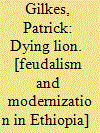| Srl | Item |
| 1 |
ID:
039417


|
|
|
|
|
| Publication |
London, Julian Friedmann Publishers, 1974.
|
| Description |
xix, 307p.hbk
|
| Standard Number |
0904130053
|
|
|
|
|
|
|
|
|
|
|
|
Copies: C:1/I:0,R:0,Q:0
Circulation
| Accession# | Call# | Current Location | Status | Policy | Location |
| 016190 | 963/GIL 016190 | Main | On Shelf | General | |
|
|
|
|
| 2 |
ID:
172182


|
|
|
|
|
| Summary/Abstract |
Insurgent organizations often experience internal fragmentation when a faction breaks away to form a separate group with independent leadership. Following a split, what factors influence the relative durability and status of groups within larger nationalist movements? Existing theory attributes variation in groups’ performance after a division to rebel strategy. Specifically, some work argues that extremist groups using violence will outbid more moderate competitors; however, alternate research contends organizations using strategic non-violence will have more success. Contrary to previous work, this inquiry argues that in many instances rebel strategy following a split has little influence on the duration and status of groups. Instead, organizations’ relative membership size at the time of a division is the most important factor influencing their subsequent performance. That is, after a split larger core groups are more likely to survive for longer periods and to advance within their broader nationalist movements than splinter groups. However, in cases when divisions result in groups of similar size and strength, strategy may still play a significant role in rebel organizations’ comparative longevity and status.
|
|
|
|
|
|
|
|
|
|
|
|
|
|
|
|
| 3 |
ID:
127890


|
|
|
|
|
| Publication |
2013.
|
| Summary/Abstract |
When and why do national movements succeed? What explains variation in the use and effectiveness of political violence employed by nationalist groups? Groups pursue common strategic goals against external enemies, such as the founding of a new state, while engaging in zero-sum competition for organizational dominance with internal rivals in their national movement. The distribution of power within a national movement provides its structure, which serves as the key variable for both the internal and external struggle. The hierarchical position of groups within the movement drives their actions, while the number of significant groups in the movement drives its effectiveness. Contrary to existing scholarship that treats nonstate coercers as unitary or suggests that united or fragmented movements perform best, hegemonic movements with one significant group are most likely to succeed. Hegemonic movement structure incentivizes the pursuit of shared strategic goals; reduces counterproductive violent mechanisms and foreign meddling; and improves the movement's coherence in strategy, clarity in signaling, and credibility in threats and assurances to yield strategic success. Analysis of seventeen campaigns involving sixteen groups within the Palestinian and Algerian national movements reveals that the power distribution theory explains greater variation in the effectiveness of national movements than previous scholarship.
|
|
|
|
|
|
|
|
|
|
|
|
|
|
|
|
| 4 |
ID:
139900


|
|
|
|
|
| Summary/Abstract |
This article examines the significant yet largely overlooked role of the Mzabis, a community from the northern edges of the Algerian desert, in Algerian and Tunisian anticolonialism and nationalism. In so doing, it pursues two aims: first, to shed light on the importance of Tunis to the politicization of the Mzabis in the 1920s and to their induction into local and regional anticolonial and national movements; and second, to highlight the tensions of subsuming regional identities into overarching national identities by focusing on Mzabi political activists’ negotiation of the relationship between the Mzab and Algeria as a national project. The article also explores the spectrum of political possibilities and alternatives envisioned by Mzabis as they participated in religious reform, anticolonial, and nationalist movements. This spectrum, I argue, conveys the fluid relationship between local, national, and regional identities, thus undermining teleological readings of national identity formation.
|
|
|
|
|
|
|
|
|
|
|
|
|
|
|
|